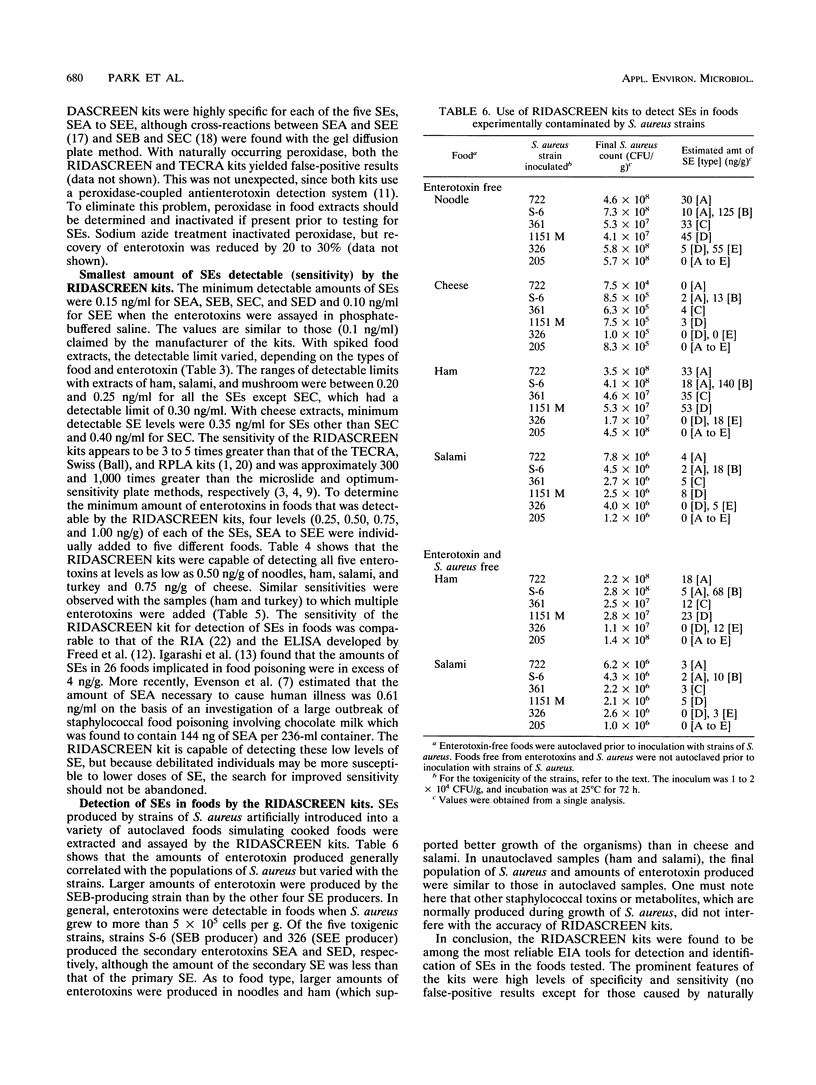Abstract
The RIDASCREEN SET kit (R-Biopharm GmbH, Darmstadt, Germany), a commercial staphylococcal enterotoxin (SE) visual immunoassay kit, was evaluated for its efficacy. The kit utilizes monovalent capture antibodies against SE types A to E (SEA to SEE); therefore, it simultaneously detects and identifies the enterotoxin types. The major advantages of the kit are (i) a high degree of specificity (except for naturally occurring peroxidases, food compositions or ingredients and microbiological products due to growth of nonstaphylococcal microorganisms did not cause false-positive results; additionally, no cross-reactions among reagents of the kits were observed), (ii) excellent sensitivity (minimum detectable limits were 0.20 to 0.30 ng of SEs per ml of extracts of ham, salami, and mushroom and 0.30 to 0.35 ng of SEs per ml of cheese extracts, or 0.50 to 0.75 ng of SEs per g of foods such as noodles, ham, salami, cheese, and turkey), (iii) simplicity (the kit enabled direct assay of SEs in food extracts without the need for lengthy extraction or concentration procedures), (iv) rapidity (it took less than 3 h to complete the analysis of individual enterotoxin types SEA to SEE), and (v) its semiquantitative results (optical density values could be read against a standard curve to estimate the amount of SE in the extract). The RIDASCREEN kit is a convenient, rapid, and reliable tool for the detection and identification of SEs in foods.
Full text
PDF




Selected References
These references are in PubMed. This may not be the complete list of references from this article.
- Bankes P., Rose S. A. Rapid detection of staphylococcal enterotoxins in foods with a modification of the reversed passive latex agglutination assay. J Appl Bacteriol. 1989 Oct;67(4):395–399. doi: 10.1111/j.1365-2672.1989.tb02509.x. [DOI] [PubMed] [Google Scholar]
- Bergdoll M. S. Analytical methods for Staphylococcus aureus. Int J Food Microbiol. 1990 Mar;10(2):91–99. doi: 10.1016/0168-1605(90)90058-d. [DOI] [PubMed] [Google Scholar]
- Collins W. S., Johnson A. D., Metzger J. F., Bennett R. W. Rapid solid-phase radioimmunoassay for staphylococcal enterotoxin A. Appl Microbiol. 1973 May;25(5):774–777. doi: 10.1128/am.25.5.774-777.1973. [DOI] [PMC free article] [PubMed] [Google Scholar]
- Evenson M. L., Hinds M. W., Bernstein R. S., Bergdoll M. S. Estimation of human dose of staphylococcal enterotoxin A from a large outbreak of staphylococcal food poisoning involving chocolate milk. Int J Food Microbiol. 1988 Dec 31;7(4):311–316. doi: 10.1016/0168-1605(88)90057-8. [DOI] [PubMed] [Google Scholar]
- Ewald S. Evaluation of enzyme-linked immunosorbent assay (ELISA) for detection of staphylococcal enterotoxin in foods. Int J Food Microbiol. 1988 Mar;6(2):141–153. doi: 10.1016/0168-1605(88)90050-5. [DOI] [PubMed] [Google Scholar]
- Fey H., Pfister H., Rüegg O. Comparative evaluation of different enzyme-linked immunosorbent assay systems for the detection of staphylococcal enterotoxins A, B, C, and D. J Clin Microbiol. 1984 Jan;19(1):34–38. doi: 10.1128/jcm.19.1.34-38.1984. [DOI] [PMC free article] [PubMed] [Google Scholar]
- Freed R. C., Evenson M. L., Reiser R. F., Bergdoll M. S. Enzyme-linked immunosorbent assay for detection of staphylococcal enterotoxins in foods. Appl Environ Microbiol. 1982 Dec;44(6):1349–1355. doi: 10.1128/aem.44.6.1349-1355.1982. [DOI] [PMC free article] [PubMed] [Google Scholar]
- Johnson H. M., Bukovic J. A., Kauffmann P. E. Staphylococcal enterotoxins A and B: solid-phase radioimmunoassay in food. Appl Microbiol. 1973 Sep;26(3):309–313. doi: 10.1128/am.26.3.309-313.1973. [DOI] [PMC free article] [PubMed] [Google Scholar]
- Lachica R. V., Genigeorgis C., Hoeprich P. D. Metachromatic agar-diffusion methods for detecting staphylococcal nuclease activity. Appl Microbiol. 1971 Apr;21(4):585–587. doi: 10.1128/am.21.4.585-587.1971. [DOI] [PMC free article] [PubMed] [Google Scholar]
- Lee A. C., Robbins R. N., Bergdoll M. S. Isolation of specific and common antibodies to staphylococcal enterotoxins A and E by affinity chromatography. Infect Immun. 1978 Aug;21(2):387–391. doi: 10.1128/iai.21.2.387-391.1978. [DOI] [PMC free article] [PubMed] [Google Scholar]
- Lee A. C., Robbins R. N., Reiser R. F., Bergdoll M. S. Isolation of specific and common antibodies to staphylococcal enterotoxins B, C1, and C2. Infect Immun. 1980 Feb;27(2):431–434. doi: 10.1128/iai.27.2.431-434.1980. [DOI] [PMC free article] [PubMed] [Google Scholar]
- Park C. E., Akhtar M., Rayman M. K. Nonspecific reactions of a commercial enzyme-linked immunosorbent assay kit (TECRA) for detection of staphylococcal enterotoxins in foods. Appl Environ Microbiol. 1992 Aug;58(8):2509–2512. doi: 10.1128/aem.58.8.2509-2512.1992. [DOI] [PMC free article] [PubMed] [Google Scholar]
- Park C. E., Akhtar M., Rayman M. K. Simple solutions to false-positive staphylococcal enterotoxin assays with seafood tested with an enzyme-linked immunosorbent assay kit (TECRA). Appl Environ Microbiol. 1993 Jul;59(7):2210–2213. doi: 10.1128/aem.59.7.2210-2213.1993. [DOI] [PMC free article] [PubMed] [Google Scholar]
- Park C. E., El Derea H. B., Rayman M. K. Evaluation of staphylococcal thermonuclease (TNase) assay as a means of screening foods for growth of staphylococci and possible enterotoxin production. Can J Microbiol. 1978 Oct;24(10):1135–1139. doi: 10.1139/m78-185. [DOI] [PubMed] [Google Scholar]
- Park C. E., Szabo R. Evaluation of the reversed passive latex agglutination (RPLA) test kits for detection of staphylococcal enterotoxins A, B, C, and D in foods. Can J Microbiol. 1986 Sep;32(9):723–727. doi: 10.1139/m86-131. [DOI] [PubMed] [Google Scholar]


